We hope you enjoy the articles and short stories presented here, and will join Kate in her adventures for many years to come.
Upon request, you will receive an inscribed copy of Kate Tattersall Adventures in China with every donation of $10 or more plus shipping. Please use the Contact Page to provide your shipping address and we will reply with your total.
Despite the popular belief, women did wear trousers in the 1800s. A search will find dozens of records of diarists who noted British and European members of the fairer sex in pants throughout Turkey, India, the American frontiers, Australia, &c. However, there is also evidence that women were having trousers made in Europe, Great Britain, and the settled portions of the Americas. Having blogged about the 19th century for a while now, I’ve come in contact with a great deal of enthusiasts. It is always enjoyable to receive a note from someone with an interesting question, or who would like to provide me with some information. This article was suggested by a curious young lady from Llanbadarn Fawr, Wales. I’m not an historian, but like to research, and approach any topic with an open mind. If you have appropriate period photos or artwork to add here, please send me a message through the contact page. What follows is a varied collection of images for whomever might be interested. Note: It was the Great War (1914-18) and the need for women to toil in combat, industrial, and heavy agricultural settings, that led to wide acceptance of feminine trousers for daily wear in the Western World, although it was illegal in Paris for ladies to appear publicly in pants without a police permit up until 2013.
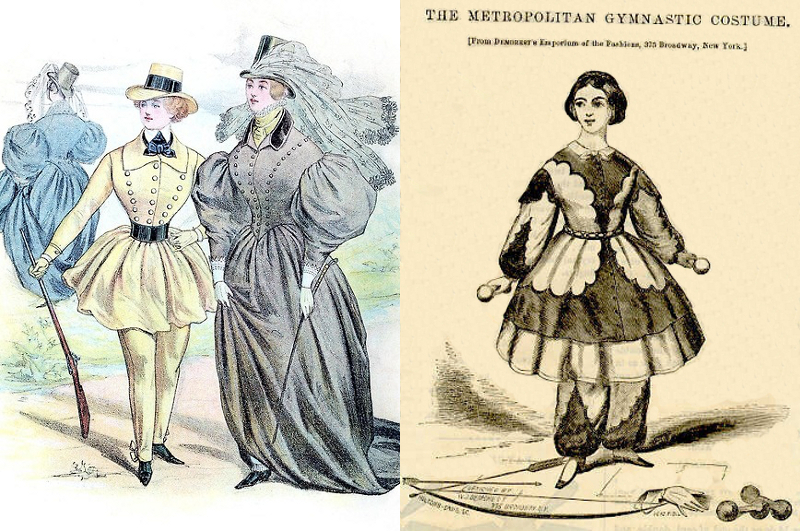
1835 fashion plate by Louis-Philippe of a lady’s hunting suit and riding habits, and an 1858 gymnastics costume from Godey’s Magazine. Note the habit skirt is drawn up enough to reveal the cuff of some kind of trousers.
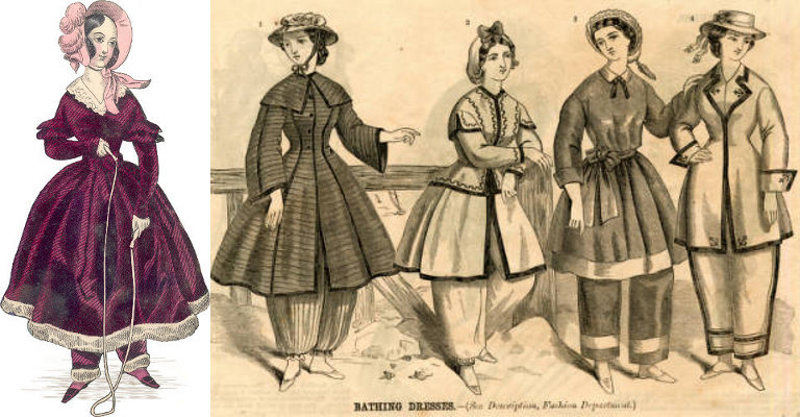
A crimson velvet fur trimmed play suit from 1838, and bathing suits from 1864, courtesy of Yesterday’s Thimble.
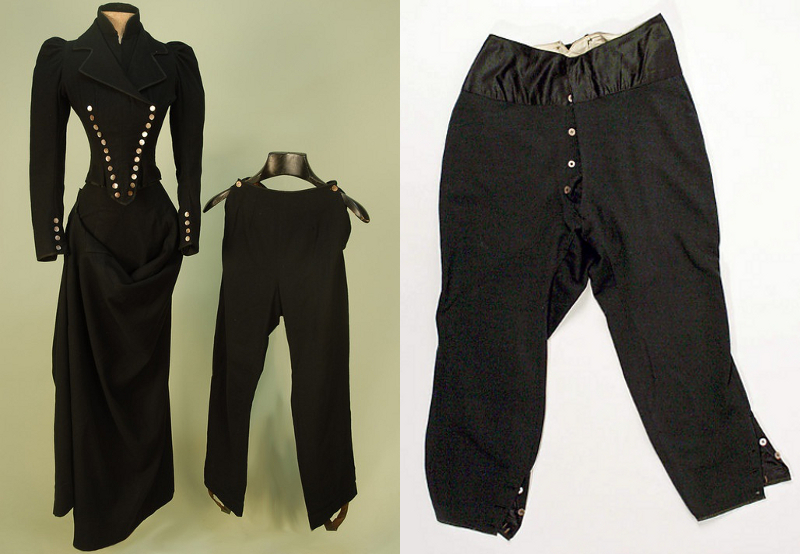
A riding habit with matching pants from 1885, and a pair of breeches, perhaps as old as the 1850s. The buttons on the left hand side on both legs are for riding side-saddle. These items are in storage at the Metropolitan Museum of Art, New York.
“At the meet, a friend introduced him to some ladies, one of whom, dressed to death, was mounted on a perfect hunter. Her costume was a blue habit edged with scarlet, with gold buttons down the front, white buck-skin trousers, and patent leather Wellingtons upon feet of exquisite symmetry. Easy to see that her habit came from Saville Row.” Who is the Heir, by Mortimer Collins, 1865. This sounds very much like the lady was wearing a habit crafted upon a man’s hunting suit, and looked fantastic.
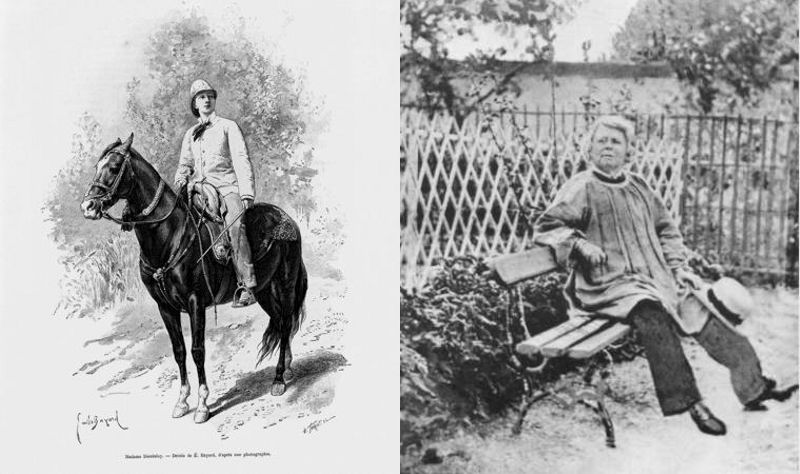
Madame Jane Dieulafoy (1851 – 1916) depicted in 1883, wore three-piece suits while travelling with her husband. Mademoiselle Rosa Bonheur (1822 – 99) obtained a special licence to wear trousers while working as an artist in Paris. The photograph here was taken in her garden sometime between 1880 – 90.
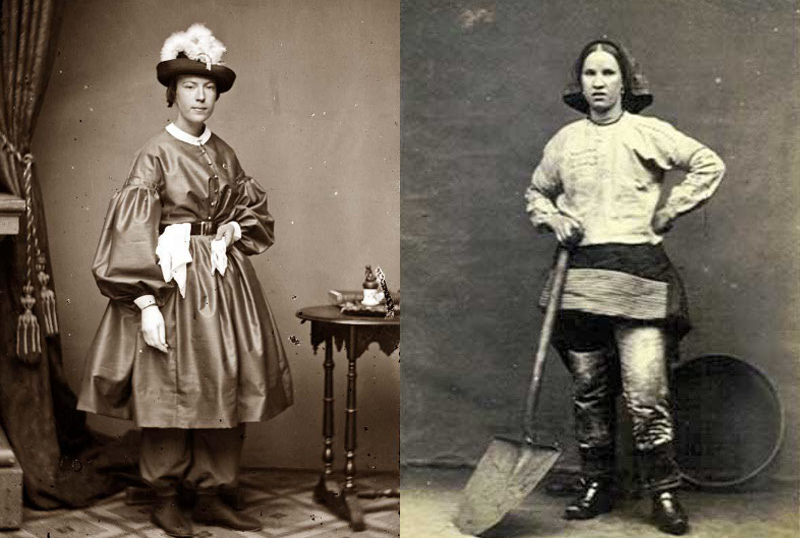
Mrs. Tibitts, taken in the 1860s, wearing a sort of bloomer suit, and a Wigan England coal miner (aka pit girl) from late in the 1800s.
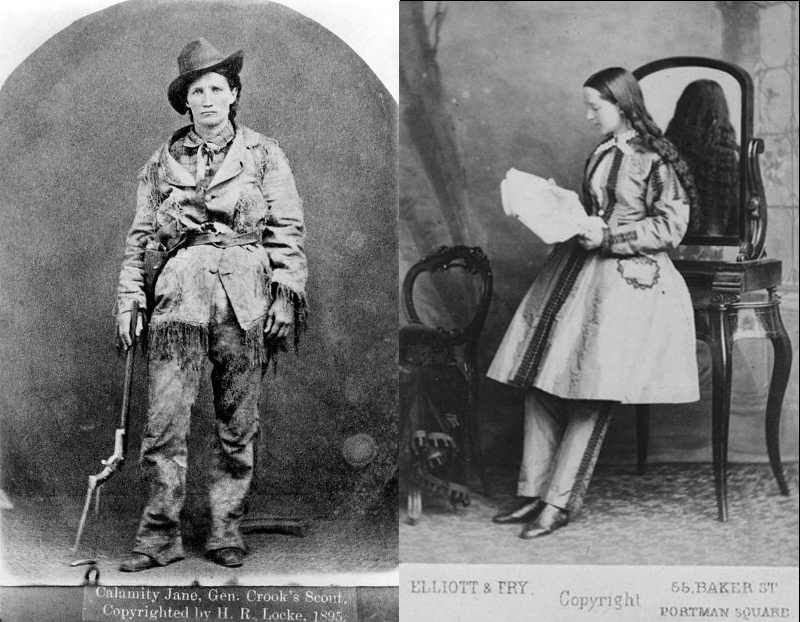
Miss Martha Jane Canary (1852 – 1903), who adopted buckskins around 1874, and Dr. Mary Edwards Walker (1832 – 1919), shown here in the 1870s, after serving as a surgeon and receiving the Medal of Honour during the American Civil War. She often wore a black suit for the rest of her life.
It is not known how many women donned uniforms and fought in the American Civil War (1861-65). Perhaps I shouldn’t include them here, but I feel they deserve recognition, and they definitely wore trousers. It is a safe bet that many adopted male clothes for certain tasks after the war.
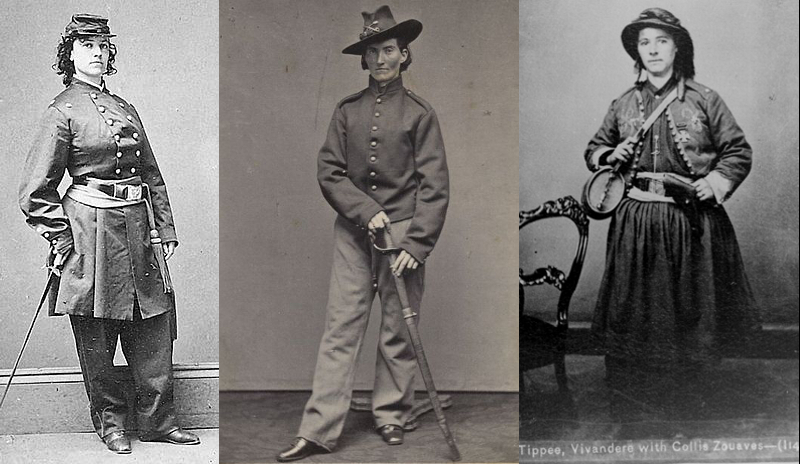
Mrs. Pauline Cushman, actress and spy, Mrs. Frances Clalin Clayton, cavalry trooper, and Mrs. Mary Tippee, vivandière with the Collis Zouaves, 114th Pennsylvania Infantry. Women served with the Confederate forces as well.
While mentioning women soldiers, the Vivandières have to be examined. The tradition of wives travelling with their husbands on campaign goes back centuries. Some time around 1700 the French Army formalized a system where certain wives were given the right to maintain a regimental canteen, which also brought them into the fold of military discipline. The word vivandière comes from vivand, meaning an article of food. Cantinière (from canteen) came into use in the 1790s, particularly with the French during their revolution (1789-99), but other countries favoured the old term. A canteen was a place soldiers could purchase alcohol, extra food, personal items like socks and handkerchiefs, perhaps bring their laundry and mending, or whatever else the women could do to make a little money and help look after the “regimental family” as a whole. In garrison the canteen may have been a room within the fort, or just a corner of the barracks, while on campaign it would have been a tent, probably set up near the cooks.
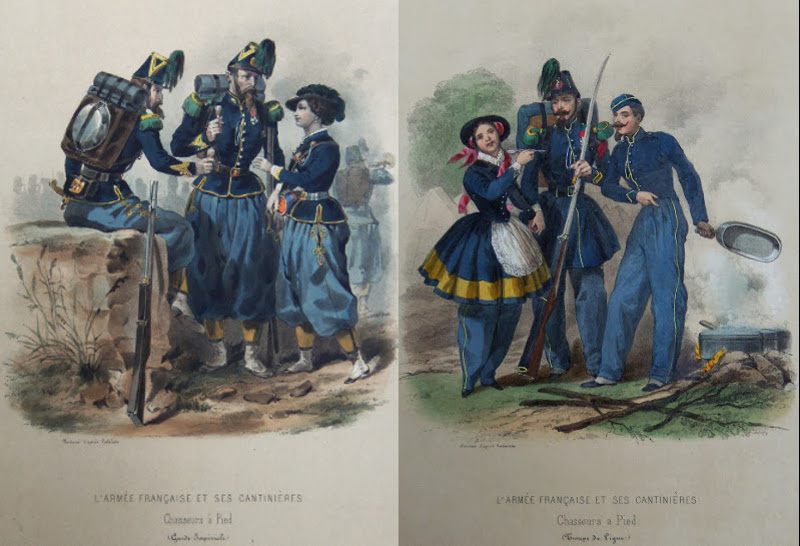
Two Chasseurs à Pied regiments. The one cantinière’s uniform is very much like the men’s, while the other is quite different.
Vivandières served with many European armies during the 1800s; Spain, Italy, Belgium, Austria, Switzerland, Russia, the Netherlands, and German states. The Dutch and Belgians called their female soldiers Marketentsters, the latter country allowing one per company, and there is a statue commemorating their service at Leopoldsburg, in the north-eastern Flemish Region of Belgium. The Austrian high command stipulated that their vivandières could march with the men provided they had no children and were supplying the troops with brandy, otherwise they travelled with the baggage train.
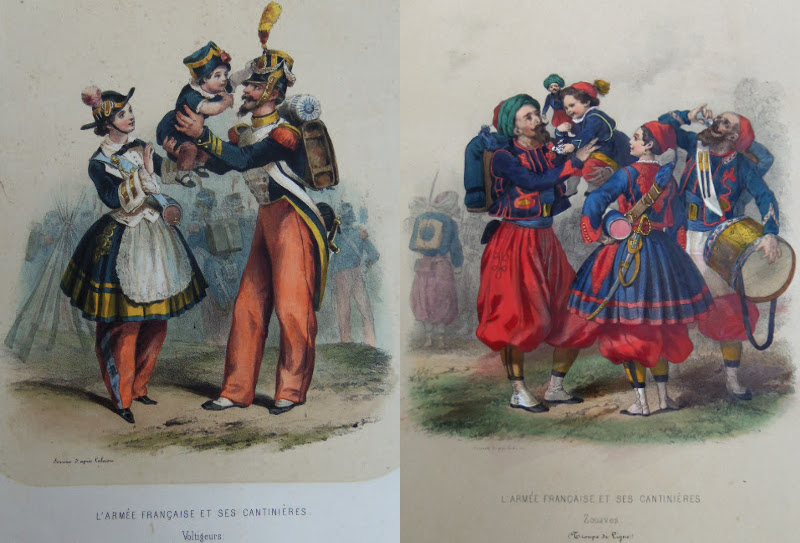
Voltigeurs & Zouaves. Note the small sabre on her hip.
Britain never instituted such a system, but did bring nurses to conflicts starting with The Crimean War (1853-56). Of course many wives and camp followers trailed any army, but they didn’t have the official status of the Vivandières. In France the tradition lasted until it was suppressed in 1906, and finally abolished when the positions were filled by disabled vets during World War I (1914-18). But the lady soldiers had been a common sight in their bright smart regimentals (which they started wearing during the 1830s) in any town with a garrison, and on any campaign, for over seven decades. Remember, at that time, soldiers wore their uniforms all day every day, seldom possessing any other clothes. The women’s uniforms were designed to match their husband’s regiment, but some were quite different, and most included a practical apron for canteen duties. The ladies were usually depicted with a brightly painted canteen (a small cask) hanging on their hips.
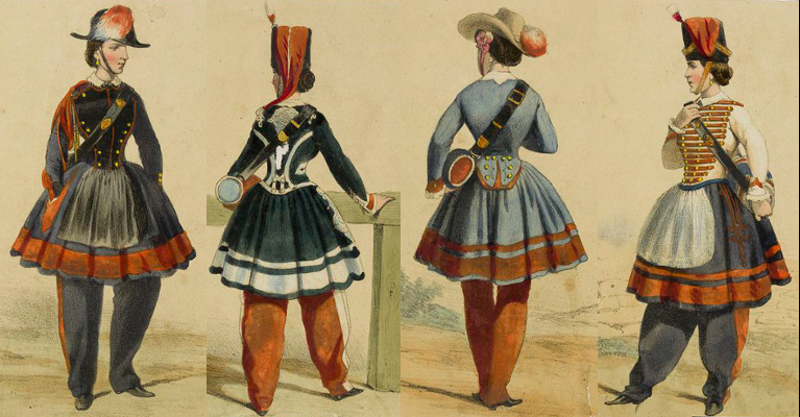
Hand-coloured lithographs, French Vivandières, 1850-70.
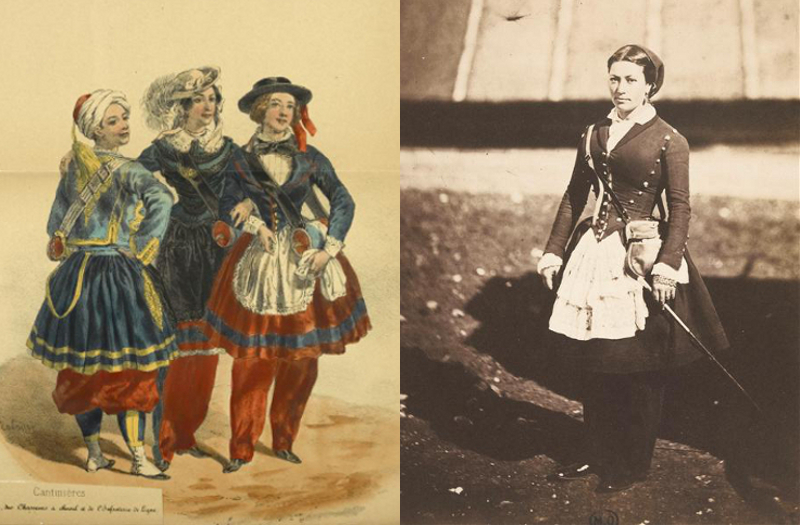
Cantinières by an unknown artist, and a photo taken by Roger Fenton in 1855 during the Crimean War.
If you would like to read more about the Vivandières and Cantinières please visit Thomas Cordoza’s website.
For dozens of images depicting women as soldiers check out Kate’s sister soldiers on Pinterest.
Note: Mass produced pants were usually made baggy, providing ample room for different physiques and upper layers of clothing to be tucked in, sewn by hand in the first half of the 19th century and then with sewing machines in the second half. Middle-class and wealthy people had their clothes tailored to fit close, following the contours of their bodies. Cavalry uniform trousers and civilian riding breeches ranged from quite roomy (but designed not to bunch up), to tight (providing support for hours in the saddle).
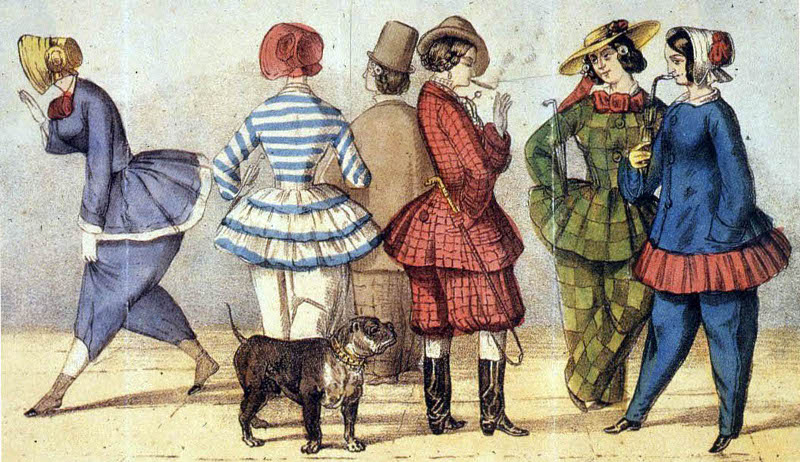
An amusing cartoon titled, Bloomer Costumes or Woman’s Emancipation, early the 1850s.

Nancy C
Just stumbled upon your site. FABULOUSNESS.
Peter
Great photos. I think practical dressing must have existed in every century.
Lisha Vidler
I just wanted to add, women also wore trousers or bloomers while ice skating. I’ve seen antique fashion plates (1860s-1870s) of ladies dressed in fur-trimmed knee-length skirts with matching trousers beneath. Quite fetching! And undoubtedly safer than trying to skate with an ankle-length skirt on.
Anne
This is very interesting. I’d like to read a book or see a film that follows a cantiniere through a war.
Noreen
Good day very cool blog!
Robert
Thanks for the information!
b
this a great blog!!
Andy Martin
“…although it was illegal in Paris for ladies to appear publicly in pants without a police permit up until 2013.”
2013??? Shirley some mistake? Don’t you mean 1913??
R.S. Fleming
It’s true, Andy, the law wasn’t struck off the books until 31 Jan 2013. In 1892 and 1909 it was amended to allow females to wear trousers, “if the woman is holding a bicycle handlebar or the reins of a horse.”
Fashion Avenger
Feminine woman look great in historical menswear for the simple reasons of showing their feminine curves & derrière off as assets to normal males plus usually wearing the sleekest & fanciest of menswear for a “killer combination” of attractiveness. The bad side is than these sexy menswear become “tainted” by heavy female usage and becomes associated now as feminine, hence, womenswear, now “lost to males” forever! That is sexism but females don’t care one iota about male fashion losses. Besides tight & fancy pants lost to females, so has leather military boots now offered to females the last 65 years as their “fashion boots” or kinky boots. Boots are sexy but now only for females.
Kathy h
Thanks for this information. Not many speak of this and I was interested in this piece of history.
Chrissy H
Thank you for this information. I am reading a book that is constantly mentioning that “she would rather wear riding britches.” It had me curious as to what they looked liked in the year 1892. I appreciate it.
Rhiannon Lynn
This is brilliant! Anyone who has read Gail Carrigers’ (steampunk) novels will know of certain characters who wear beautifully tailored masculine clothing…the most notable one being an inventor of French extraction, whose suits are always perfect. 🙂 Brilliant info, thanks!
Lisa Martick
I stumbled upon your fascinating site wanting information on 1800’s women’s fashions. I thought I knew a lot about the basics concerning what was worn. I have been enlightened! Truly fascinating! I never would have thought women would have been able to leave the house with these shorter dresses and pantaloons without being thrown in the paddywagon!!
fran
Here’s a link showing Dr. Mary Edward Walker wearing trousers.
http://www.jocelyngreen.com/2015/03/29/5-pioneering-women-doctors-and-nurses-of-the-civil-war
M. Muggins
Surely you don’t mean “2013” when you cite the date that women no longer needed a permit in Paris to wear trousers!!!
R.S. Fleming
It’s true; the law wasn’t amended until 2013. (It probably hadn’t been enforced since the 1940s.)
Theresa
I have a pioneer day at my school for the fourth grade. More and more in recent years girls do not want to wear dresses with bonnets etc. In what situations, conditions, circumstances would a girl of 9-11 years dress more like a boy during the 1860s in America? Thank you for your help.
R.S. Fleming
Hi Theresa. Girls doing hard labour would often wear trousers under their skirts, and wide-brimmed straw hats if outside. Indoors they might only wear a kerchief on their heads to keep hair under control. Poor families would hand down clothes, so a girl with elder male siblings might dress in shirts and trousers. And the girls would have worn trousers to ride horses, as pioneers weren’t hauling around sidesaddles. Respectable urban girls with any money in their family wore dresses and bonnets. I hope that helps.
Theresa
Thank you! Very helpful!!
Lisa
Hey I just found your blog and I’m really thrilled that I found it, it’s very interesting!! I was doing some research for a character design I’ve been working on (for illustration purposes), and my character is a woman who wants to be independent in the 19th century. Now I know that women actually wore pants during this century and I had no idea, so thank you very much for this article!
Belle
Hello, thank you for the interesting blog! I have a question: I am assuming the bloomers would be closed legged, unlike the trousers used as underwear? If this is the case, would the woman have to undress every time they used the lavatory?
R.S. Fleming
Hi Belle, yes, the bloomer trousers were very much like harem pants, and pulled on with the jacket or coat. Women could just undo a button or two to get at the drawstring of their bloomers, then pull them down, split-drawers underneath.
Aaron
It was enforced but very loosely. I always find it interesting that they show women on Little House on the Prairie slaving over a plow in the fields or on a camping trip with a dress dragging on the ground. Its dumb even for that time. I don’t care what anyone says, if something doesn’t make sense it isn’t true. This just doesn’t cut the mustard. Maybe in public women were in dresses but while doing labor jobs they must have had some form of outfit accordingly.
Tom
R.S, Fleming, very interesting article and I like the pictures. It is my understanding that the first trousers were worn by the horse riders of the area surrounding the Black Sea and into Central Asia and that women and men wore these garments so it may be that women were among those who first wore trousers. Tom
R.S. Fleming
Interesting. Thanks, Tom.
Leslie Thaggard
Very interesting. Thank you. Paris law not changed until 2013 is crazy. Wonder what other crazy laws are still on the books…
Scott W Snyder
I have a certified c.1890’s denim jacket designed for a working farm woman. Have you ever seen or heard of such a thing? I can find nothing to verify the clothing archeologist’s assesment.
R.S. Fleming
Hi Scott, an archive search of the 1800s finds many examples of women’s work jackets of various materials, including denim.